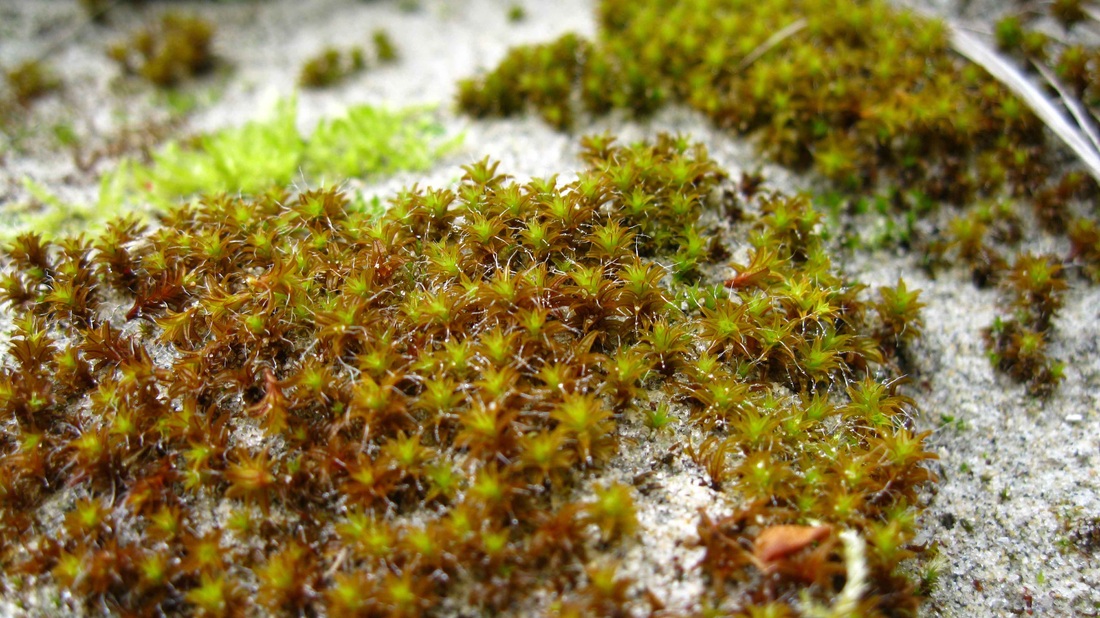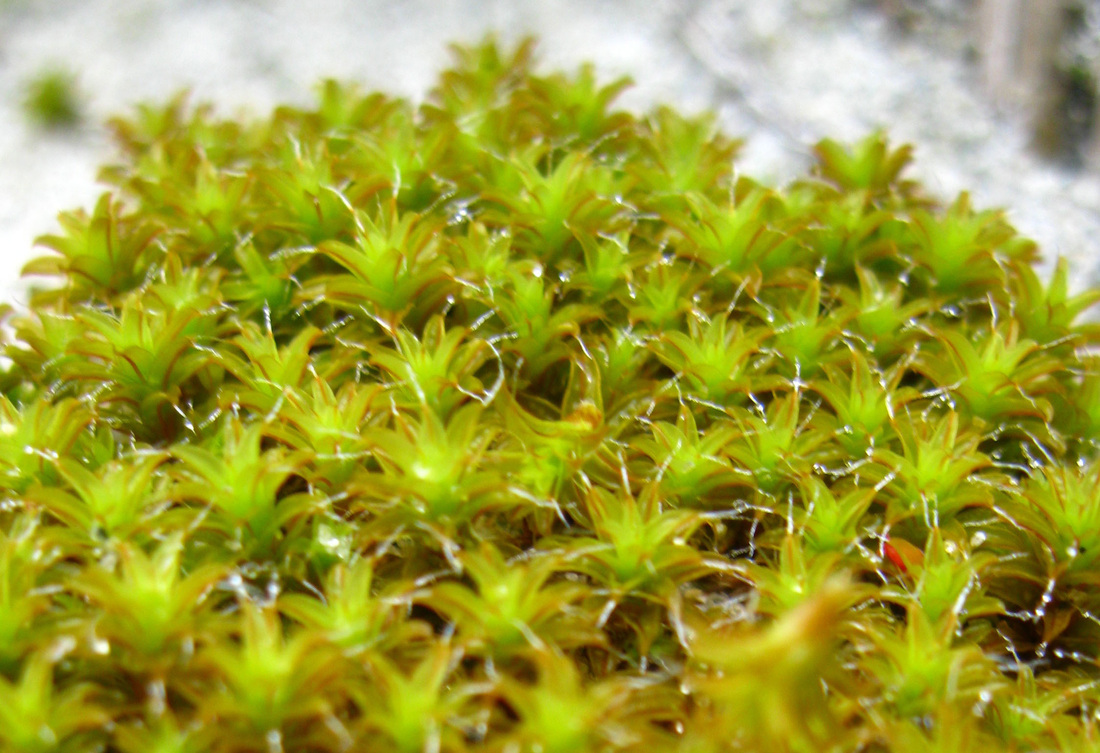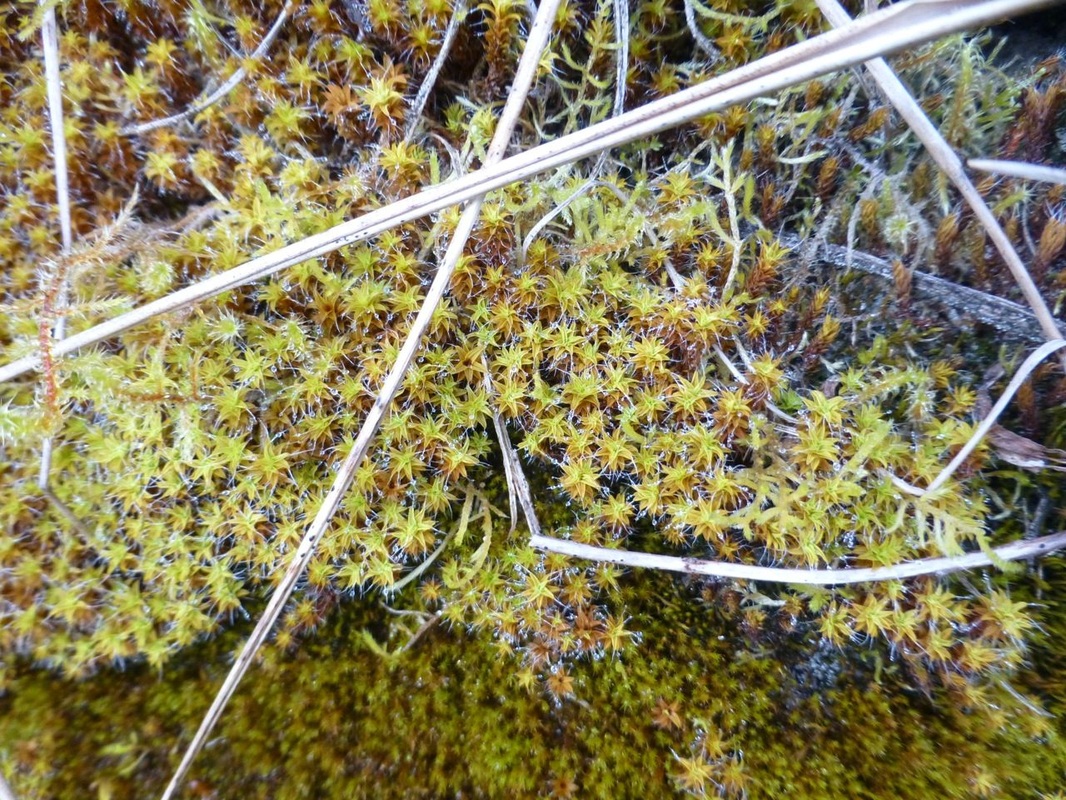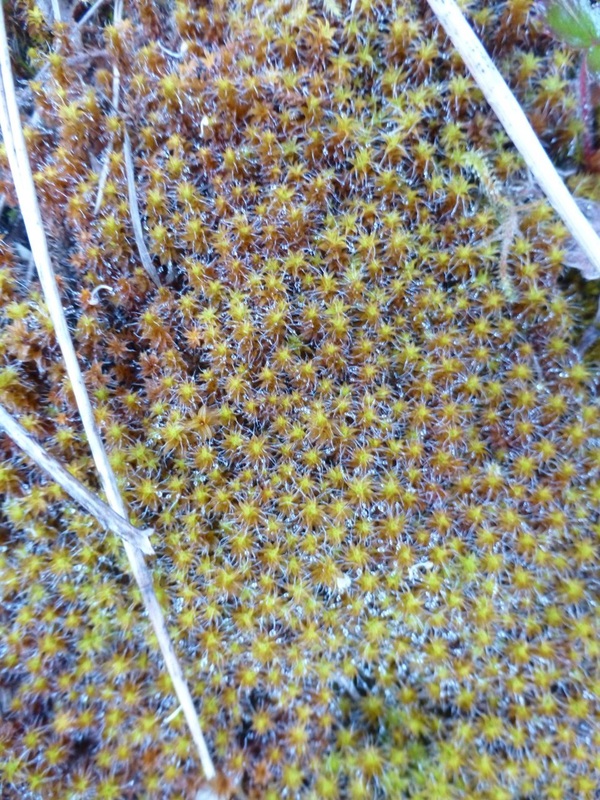Sidewalk moss, hairy screw moss, tortula moss • Tortula ruralis, Syntrichia ruralis
{Tortula = twisted; ruralis= 'of the countryside'}
Identification
Sidewalk moss has dark green to reddish-brown plants. The stems grow upright to 8 cm tall and are unbranched or infrequently branched. The leaves are oblong with a clear, toothed, bristly point and a strong midrib that extends into the bristle point. Moisture levels change the look of the species drastically: when wet the leaves are spreading and curve outwards at right angles, creating a flower-like effect. When dry the leaves contort into a twisted, upright position.
Habitat & Range
Sidewalk moss grows in crevices and on soil and rock surfaces in locations that dry out periodically. It is found in a variety of habitats around the world, including tundra, grasslands, coniferous forests, and deserts. Its western North America range extends from Alaska to Mexico.
Similar Species
Sidewalk moss could be confused with other members of the Tortula or Syntrichia genera. The leaves of brown screw-moss (Tortula princeps) pinch in halfway along their length and then widen again; the leaves of sidewalk moss are distinctly tapered to the tip in comparison. Norwegian tortula moss (T. norvegica) has red bristle-points and is found at higher elevations. Similar-looking species such as awned haircap moss (Polytrichum piliferum) lack the same oblong leaves with distinctive long, clear bristle-points.
iNaturalist
https://www.inaturalist.org/taxa/244075-Syntrichia-ruralis
Sidewalk moss has dark green to reddish-brown plants. The stems grow upright to 8 cm tall and are unbranched or infrequently branched. The leaves are oblong with a clear, toothed, bristly point and a strong midrib that extends into the bristle point. Moisture levels change the look of the species drastically: when wet the leaves are spreading and curve outwards at right angles, creating a flower-like effect. When dry the leaves contort into a twisted, upright position.
Habitat & Range
Sidewalk moss grows in crevices and on soil and rock surfaces in locations that dry out periodically. It is found in a variety of habitats around the world, including tundra, grasslands, coniferous forests, and deserts. Its western North America range extends from Alaska to Mexico.
Similar Species
Sidewalk moss could be confused with other members of the Tortula or Syntrichia genera. The leaves of brown screw-moss (Tortula princeps) pinch in halfway along their length and then widen again; the leaves of sidewalk moss are distinctly tapered to the tip in comparison. Norwegian tortula moss (T. norvegica) has red bristle-points and is found at higher elevations. Similar-looking species such as awned haircap moss (Polytrichum piliferum) lack the same oblong leaves with distinctive long, clear bristle-points.
iNaturalist
https://www.inaturalist.org/taxa/244075-Syntrichia-ruralis
References
Matthews, Robin F. (1993). Tortula ruralis. In: Fire Effects Information System, [Online]. U.S. Department of Agriculture, Forest Service, Rocky Mountain Research Station, Fire Sciences Laboratory (Producer). Accessed 09/10/2014.
Pojar, J. and MacKinnon, A. (1994). Plants of Coastal British Columbia. Vancouver, BC: Lone Pine Publishing. P. 477.
Syntrichia ruralis (Hedwig) Weber & D. Mohr [Pottiaceae]. California Moss eFlora. University Herbarium, University of California, Berkeley. Accessed 09/10/2014.
Vitt, D. H., Marsh, J. E., and Bovey, R. B. (1988). Mosses Lichens & Ferns of Northwest North America. Vancouver, BC: Lone Pine Publishing. P. 120.
Authors and editors of page
Kelly Fretwell, Ian Cruickshank, and Brian Starzomski (2014).
Matthews, Robin F. (1993). Tortula ruralis. In: Fire Effects Information System, [Online]. U.S. Department of Agriculture, Forest Service, Rocky Mountain Research Station, Fire Sciences Laboratory (Producer). Accessed 09/10/2014.
Pojar, J. and MacKinnon, A. (1994). Plants of Coastal British Columbia. Vancouver, BC: Lone Pine Publishing. P. 477.
Syntrichia ruralis (Hedwig) Weber & D. Mohr [Pottiaceae]. California Moss eFlora. University Herbarium, University of California, Berkeley. Accessed 09/10/2014.
Vitt, D. H., Marsh, J. E., and Bovey, R. B. (1988). Mosses Lichens & Ferns of Northwest North America. Vancouver, BC: Lone Pine Publishing. P. 120.
Authors and editors of page
Kelly Fretwell, Ian Cruickshank, and Brian Starzomski (2014).








